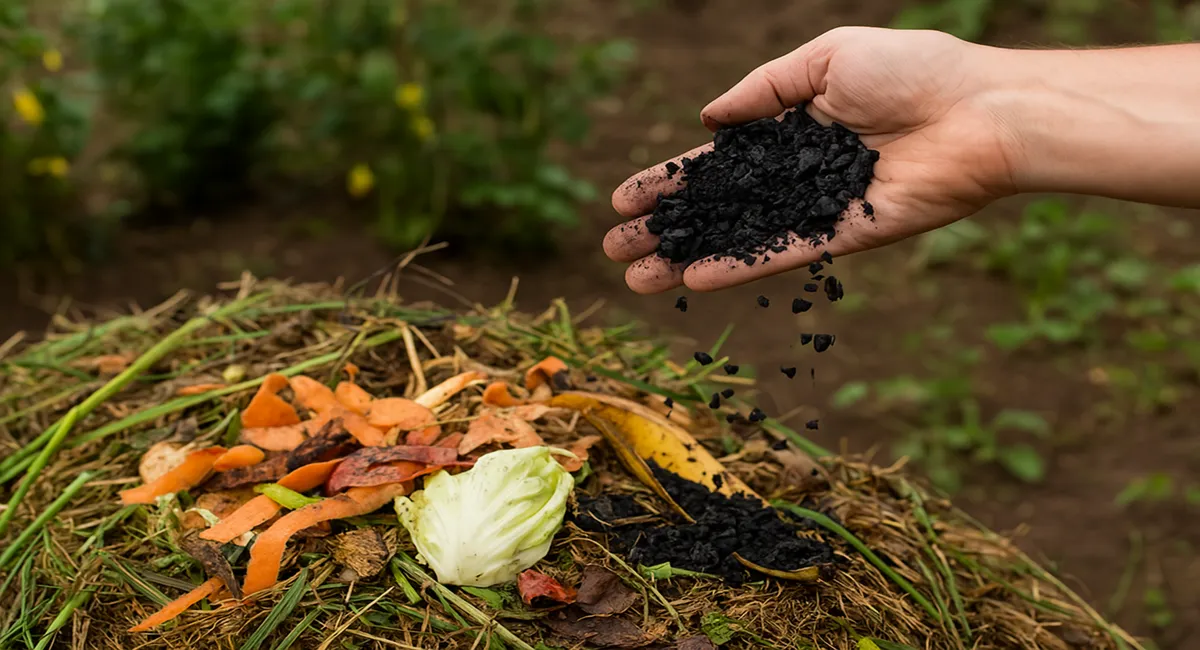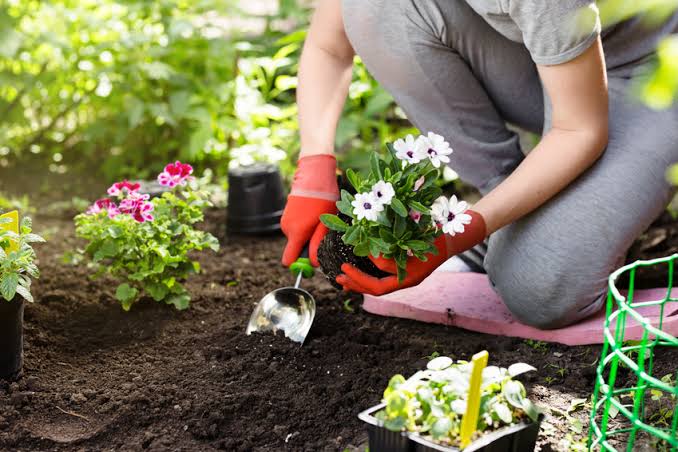Carbon compost is revolutionising sustainable gardening and farming practices. Knowing the potential of this substance can change how you tend to your plot and specimens, regardless of your level of experience.
This guide will show you how to harness the power of this substance for long-lasting crop health and eco-conscious cultivation. Are you ready to give your garden the boost it needs? Here’s how this component can help.
What Is Biochar?
It is a carbon-packed substance made from wood chips and plant leftovers. It is created through a process called pyrolysis where materials are heated without oxygen, turning them into this additive while keeping most of their carbon content.
Unlike regular compost, which eventually breaks down and releases carbon dioxide, this element remains solid in the ground. It acts like a long-term carbon storage system.
Long ago, people in the Amazon used it to boost fertility. This created those renowned dark soils called Terra Preta.
Scientists today are thoroughly invested in biochar research because it helps beneficial microbes thrive, making it excellent for farming.
It also improves the soil’s ability to retain nutrients, which increases its health. Additionally, it captures carbo,n which reduces overall greenhouse gases.
How It Improves Soil Health
Professional gardening experts explain that this component creates tiny air pockets in the earth that help roots grow better and grab more nutrients. You probably know how quickly water drains away in sandy or loose soil.
Conversely, carbon compost acts as a natural water reservoir. Thus it will hold onto moisture so your cultivars can make use of it whenever they need to. This means less frequent watering but also healthier plants.
Additionally, carbon composting attracts all the helpful organisms that make your soil rich and healthy.
Another benefit relates to proper plant feeding. The material slowly releases its nutrients which means less fertilise use overall. This will both save money and aid the planet.
Moreover, your specimens will grow stronger and produce bigger harvests all thanks to this steady nutrient supply.
Once you mix this additive into your garden soil, it will keep working its magic year after year. It’s a simple change that will really make a big difference.
Environmental Benefits
Using this compound will greatly benefit the environment. That’s mainly because it will prevent carbon from becoming CO2. All this helps combat climate change.
Furthermore, combining compost and biochar reduces methane and nitrous oxide emissions. This showcases its importance in efficient waste management.
It also has the capability to modify acidic soils, which pose a risk to plant development. By adjusting the pH levels and supporting crop growth it creates a significant impact on both ecosystems and agricultural sectors.
Choosing the Right Type
When selecting biochar for your garden or farm, knowing its origin is essential. Different materials, such as wood, plants, or manure, give it unique traits that impact your plot.
Wood-based varieties, for example, work effectively for sandy gardens by boosting air and water flow. Meanwhile, manure-based types add additional nutrients.
Choose one from sustainable sources. Look for certifications from trusted environmental groups to ensure it is green.
Consider the size and surface area of the pieces. When the sections are smaller, their total surface area increases significantly because there are more individual pieces with more edges.
The more pieces you have, the more surface area is available for things like water, nutrients, and beneficial microbes to adhere to. This helps with nutrient retention, which is ideal for clay or compacted soils needing high levels of sustenance and airflow.
Additionally, production temperatures matter. Higher temperatures make a stable, carbon-rich product, which is excellent for long-term soil health. Finally, purchasing local products reduces transport pollution and supports domestic businesses.
How to Apply It
Including this component as part of your gardening or farming practices can be a straightforward procedure that notably improves your specimens’ health. Initially, determine the right amount of additive needed depending on the soil’s type and your goals.
Typically, a 5-10% volume ratio of the substance, blended with other types of compost, is ideal for uniform distribution.
Start by dampening the charcoal. This will make it easier to combine with the dirt and benefit from its effects immediately.
After applying it, attentively monitor your plot. Take into account factors, such as pH level, moisture content, and plant growth. You will need to make adjustments to maintain a balanced ecosystem.
Combining It With Other Enhancements
Charcoal and compost mixing will give your garden a strong boost. Biochar itself has a honeycomb-like structure. This creates perfect little homes for all beneficial microorganisms. In turn, the soil gets more nitrogen.
So essentially this combination makes the soil less compacted. It will thus hold water better and provide more nutrients to your cultivars.
Adding natural fertilisers to this mix makes it even better. Think of it as a storage system. It captures and holds onto nutrients from these fertilisers, releasing them slowly to your greenery over time. This means less waste and better-fed specimens.
For raised beds, try building your soil in layers. Start with biochar at the bottom, add layers of compost and natural fertilisers, and finish with good topsoil. This creates an excellent growing environment for your vegetation.
Cost-Effective Tips
While commercial products are available, there are several practical strategies to obtain this valuable enhancement affordably. Here are several approaches to consider for acquiring carbon compost economically.
Local Sources and Methods
Do you want to boost your garden without spending too much? Professional gardening experts recommend checking out local community gardens or farming groups for affordable biochar.
Moreover, they often have suggestions regarding economical suppliers who offer discounts for bulk purchases.
Creating Your Own Biochar
Before starting, gather your materials. You’ll need hardwood chips or agricultural prunings, a metal drum with ventilation holes, a reliable heat source, and basic safety equipment. Always keep a water source nearby for safety and quenching.
Begin with thoroughly dried organic material, preferably hardwood pieces sized between 2.5 to 7.5 cm. Place these materials in your metal container, heat steadily until smoke emerges, and then maintain a consistent temperature.
The process typically takes 3-4 hours, and you’ll know it’s complete when the smoke becomes thin and bluish. Allow the material to cool in an oxygen-limited environment.
Bulk Purchasing and Workshops
Buying in bulk can reduce costs significantly. Joining local workshops is a smart decision too. You will learn useful tips and save money. Additionally, it is excellent for the environment.
Explore these options, and you will improve your soil affordably. Getting involved in local workshops can help you find additional budget-friendly ways to make this enhancer.
Potential Drawbacks and Considerations
It is important to address some misconceptions surrounding biochar, as it is not a short-term solution.
Most users observe significant improvements after several months, with optimal results developing over multiple growing seasons. This long-term approach requires patience and consistent monitoring.
Not all products meet the same standards, and poor-quality variants can introduce contaminants or fail to provide expected benefits.
Hence, research manufacturers thoroughly, focusing on those with established reputations and transparent production processes. Request documentation about their testing procedures and quality control measures.
While this substance excels at nutrient retention, improper application can temporarily disrupt your garden’s nutrient balance. Excessive application could bind nutrients too tightly, preventing the plants from making use of them.
Moreover, adjust the ratio based on the results. This will prevent any potential nutrient deficiencies or imbalances.
In addition, test the soil to establish a baseline. After that, track changes in nutrient levels, pH, and organic matter content.
Conclusion
Carbon compost is a sustainable solution to farming. It enhances soil health and as an added benefit it also helps to combat climate change.
This makes it an excellent choice to enrich your soil and also do a little bit for the planet. Start small and watch as your garden flourishes. Ultimately, carbon compost will provide you with vibrant plants for years to come.











